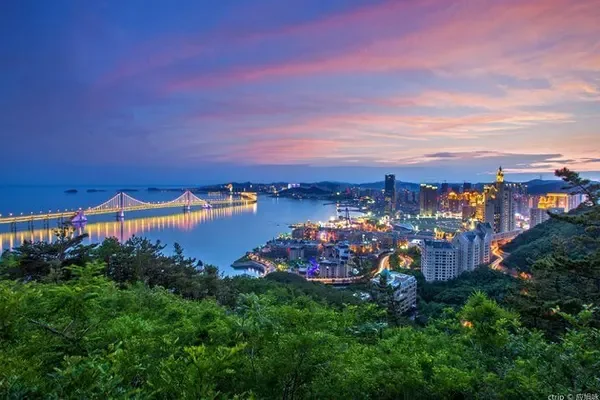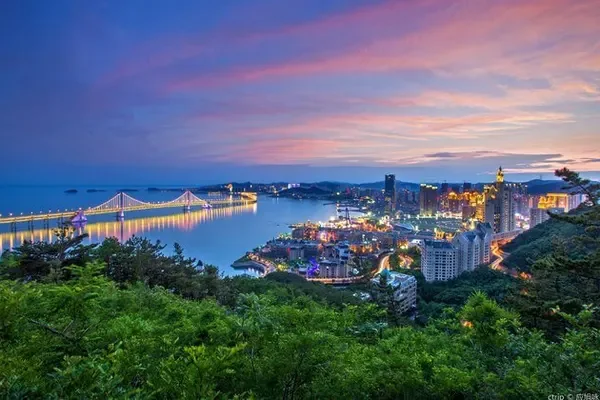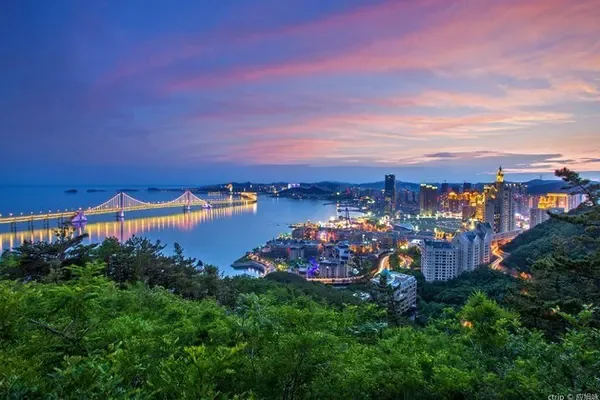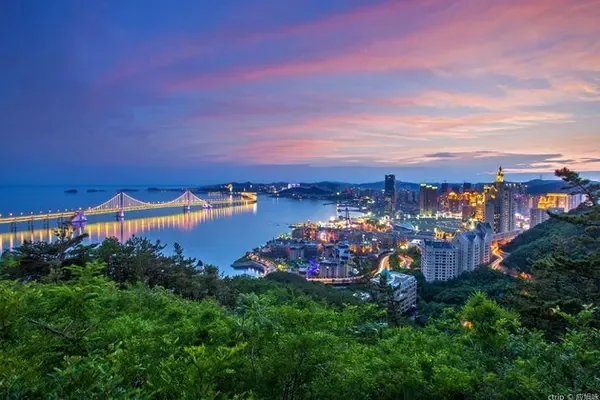After watching the world-renowned National Day military parade in Beijing, the capital, it is time to go out and look around! Is there a place with less traffic? Tangshan replied loudly: I have a tour of the Great Wall in autumn, without people looking at people or traffic jams. The beauty of the scenery will definitely make you happy this autumn. Speaking of Tangshan, Hebei Province, most people think of coal, steel, or a major earthquake. In fact, Tangshan is rich in tourism resources. It not only has the well-known world cultural heritage, the most complete existing scale, the largest system, and the most appropriate layout of the national 5A-level scenic spot Qingdong Tombs; it also has another world cultural heritage, the winding The Great Wall stretches 220 kilometers and has 29 famous passes.




History of the Palace of the Qing Dynasty
It took 272 years to build the Eastern Tombs of the Qing Dynasty. Among them are: Shunzhi, the first emperor who entered the customs, Emperor Kangxi who created the prosperity of Kangxi and Qianlong, Qianlong, an old man with both civil and military skills, empress Xiaozhuang Wen, an outstanding female politician who assisted Shunzhi and Emperor Kangxi, and Cixi who listened to politics twice behind the curtain. The concubine Xiang, who gives people a sense of confusion... These people who once dominated the destiny of the country and played an extremely important role on the political stage of the Qing Dynasty are now buried here, allowing nature to baptize and history to comment. "A Qing Eastern Mausoleum, half of the Qing palace history". No wonder the United Nations World Heritage experts praised the Eastern Tombs of the Qing Dynasty as "a masterpiece of human creative genius". Among the more than 580 single buildings in the mausoleum area, there is the widest existing stone archway in the country that has not moved for 330 years after two major earthquakes; there is a 5.5-kilometer-long main road to the Xiaoling Mausoleum; the sound of knocking is like a golden bell There is the "Wuyin Bridge"; there is the Yuling Underground Palace known as the "Treasure House of Stone Carving Art" and "Underground Buddha Hall"; there are also three halls of Cixi Mausoleum built with precious huanghuali wood and decorated with gold; She was overwhelmed by her superb art, and even more impressed by her magnificent momentum.




The Great Wall at the top of Yanshan Mountain
The Xifengkou Great Wall is famous for its long history but never being artificially restored and well preserved. In the north of Tangshan, from west to east, the Great Wall at Jiufeng Mountain in Zunhua and the Panjiakou Underwater Great Wall in Qianxi are both representative of the essence of the Great Wall. Jiufeng Mountain Ancient Great Wall is the original Northern Qi Great Wall with a history of more than 1400 years. There is a section of the Great Wall that is 1,200 meters long and the narrowest point is only 70 centimeters. It is known as the "narrowest and shortest" section of the Great Wall. It is said that the officials who built the Great Wall embezzled money and cut corners, which is a typical "Great Wall of Tofu". From here, head east to Panjiakou Reservoir. The Panjiakou and Xifengkou Great Walls have a history of more than 500 years here, and are famous for being well preserved without artificial restoration. These two are two important passes of the Great Wall of China in the Ming Dynasty, and they were also the main throats from the Central Plains to the northern border and the northeast border at that time. In 1975, the Panjiakou Reservoir was built here. After the impoundment, the water level exceeded the height of the Great Wall. The two Great Wall passes, Xifengkou and Panjiakou, were submerged in the water. When the Great Wall passed through the two reservoir areas of Panjiakou and Xifengkou, it circled down from the high mountains and stretched into the bottom of the water. Here and now, the Great Wall is like a giant dragon, with its head stuck in the lake to drink water, and its body still hovering on the mountain. Its magnificent scenery is unparalleled in the world.




Tangquan was famous 1600 years ago
Tangquan Palace is located on the west of the historical site Qingdong Tomb and on the north of the Great Wall. It has a long history and profound cultural heritage. Because the spring water boils like soup in four seasons, it is named "Tangquan" and has the reputation of "the first spring in Jingdong". After textual research, there is a record in Li Daoyuan's famous book "Shui Jing Zhu": there is a hot spring in the north of Yuyang. The "Scenery History" of the Ming Dynasty also mentioned: "The hot springs in the world are the most famous in Lishan, the cleanest Xiangxi, and the hottest Zunhua Tangquan". Since the Tang Dynasty, it has become a place for royal bathing and healing. Emperor Taizong of Tang Dynasty, Empress Dowager Xiao of Liao Kingdom, Qi Jiguang, Xiaozhuang, Kangxi, Yongzheng and Qianlong all stayed here. Qi Jiguang, a famous anti-Japanese general in the Ming Dynasty, built the Liubei Pavilion, the hot spring pool and the hexagonal stone building here in 1577, which have a history of more than 400 years. In the cool autumn day, jump into the hot spring with a suitable temperature, close your eyes, feel the bubbling heat coming out of your body non-stop, relax your body and mind, and enjoy the kindness of the hot spring. At this time, the hustle and bustle of the world is far away, the pressure of the city is washed away, people's heart knots are also untied, and the long-lost comfort comes to mind. At this time, you will find that hot springs are not only a patent for winter, but autumn is also suitable, and hot springs are really like some people say-the "hometown of the heart", which can let your mind fly and delight your body and mind.




1872 steps to the summit
A deity makes a mountain, not its altitude. Jingzhong Mountain, which is 610 meters above sea level, is really not high, but because of its beauty, it has been dubbed the name of "Jingdong Famous Xiu". It is famous in the east of Hebei. Jingzhong Mountain not only has Buddhist Buddha Hall, Bodhisattva Hall, and Sishuai Hall, but also Taoist Bixia Yuanjun Hall, Jade Emperor Hall, and Zhenwu Emperor Hall, as well as three outstanding loyal ministers respected by Confucianism Zhuge Liang, Yue Fei, and Wen Tianxiang. The "Three Loyalty Shrine", the first temple building can be traced back to the Song Dynasty. In the third year of Jiajing in the Ming Dynasty, Ma Yong, the general officer of Jizhen, built the Bixia Palace and the statue of Feng Yuanjun on the east side of the "Sanzhong Temple". After that, Qi Jiguang, the chief soldier of Ji Town, carried out two large-scale repairs successively. Emperor Shunzhi and Emperor Kangxi of the Qing Dynasty paid special attention to Jingzhong Mountain. They have visited Jingzhong Mountain six times. There are stele inscriptions to record that the establishment of the prince in Shunzhi was made after the divination in Jingzhong Mountain. Jingzhong Mountain was actually regarded as a royal family temple in the early Qing Dynasty. The emperor of the Qing Dynasty not only allocated silver to build the temple, but also granted a 16-jin 4 taels of golden lady and more than 4,500 volumes of "Tripitaka". As a result, Jingzhong Mountain became famous all over the world. Every year on the 18th of April and the 15th of October in the lunar calendar, there are two large-scale temple fairs in Jingzhong Mountain. Devotees and believers come from all over the world, and there is an endless stream of them within ten days.




The romance of living in the "Homing Tribe"
The homing tribe located in the first chestnut village in China - North Yangjiayu Village, Qianxi County, originated from an ancient legend. According to legend, in the early Paleolithic Age, Youchao led his people to live on top of tall trees in order to avoid beasts on the ground. After decades of continuation, a group of people migrated to the Yangjiayu area. They were delighted to see chestnut trees all over the mountain, so they used chestnuts as food and trees as their houses, and finally formed a tribe, the predecessor of today's Homing Tribe. The homing tribe still inherits the ancient farming civilization. They not only plant cash crops such as chestnuts on a large scale, but also domesticate and raise prey. Currently, they breed chickens, ducks, geese, rabbits, sika deer, ostriches and other rare animals. The problem of housing is solved, and of course the people's livelihood is also indispensable-after eating, the most distinctive food in the tribe is the whole deer banquet, which has been on our big CCTV! It is fulfilling to be in the homing tribe, wake up by birdsong in the morning, stroll in the tribe, look at chestnut trees and chestnut fruits in the chestnut forest, play with ostriches and deer, taste the special chestnut and deer feast at noon, and then take a nap , who like to drink tea and play chess quietly, and those who like sports go to the river to fight water fights, catch fish and shrimp, sing songs and dance by the campfire at night, sleep in a wooden house on a tree, it is really leisurely and contented one day.




Autumn on the Great Wall Mountain Greenway
Yanshan Mountain, in the north of Qian'an, is majestic and stretches continuously. The Great Wall and the Greenway are like two free-stretching vines, winding their way across the ancient mountains. In fact, the Great Wall and the greenway are integrated together. Therefore, the people of Qian'an call this 49-kilometer tourist road that accompanies the Great Wall and passes through 26 villages the Great Wall Mountain Greenway. Hongyukou Village in the depths of Yanshan Mountain is the starting point of the Great Wall Mountain Greenway. The average life expectancy of people here is more than 80 years old, and it is known as "China Longevity Village". From Hongyukou to the east, there are large expanses of terraced fields along the way. From low to high, the drop of terraced fields reaches hundreds of meters. This is the construction result of the local people's encircling the mountain project in the 1970s and 1980s, and it is also the crystallization of hard work and wisdom in farming production. The Langya Great Wall is the most worthwhile place to appreciate during this mountaineering trip. It is built along the mountain at a nearly 45-degree angle, and the relatively intact part of the city wall stands like a zigzag along the mountain. The charm of the Langya Great Wall lies not only in its amazing beauty sitting on the top of the mountains, but also in the courage of the climbers. In this mountain, the shapes shaped by nature are inherently romantic. As long as you open your eyes to discover beauty, one landscape after another will come one after another.




Touch 3.85 billion-year-old multicolored stones
Originally wanted to see the mountain, but walked into the ancient beach. Walking into Yamahaguchi in autumn, you feel like you are in the underwater world where the sea water recedes. The mountains and forests are verdant, the air is pleasant, and the clear springs flow from top to bottom and around the mountains, and the flowing water is endless. The Shanyekou Scenic Spot of the National Geopark is located in Shanyekou Village, Dawuli Township, Qian'an City, with a total area of 14 square kilometers. According to the research of geological experts, the colorful stones here are the pebbles and sediment of the ancient seabed 3.85 billion years ago. High temperature and high pressure, and formed by crustal movement, it has the reputation of "submarine colorful amber". The rich and complete archaic landforms here are known by geologists as the "holographic submarine geological archives". 2.5 billion years ago, the crust of Shanyekou rose, creating tall mountains. After long-term weathering and erosion, the layers of mountains were finally flattened into low plains. From 1.8 billion years ago to 1.4 billion years ago, sedimentary rocks were formed during this period, and the earth’s crust underwent downward movement and received deposition. Conglomerate was formed in the river environment, sandstone and shale were formed in the coastal swamp environment, and sandstone and shale were formed in the shallow sea environment. Dolomite is formed. After that, these sedimentary rocks experienced ups and downs, fault folds and great changes, and finally formed the current unique geological and landform landscape.




RV camping town by Lixiang Lake
The fertile Luan River runs through the entire area of Qianxi, and the two large national reservoirs, Panjiakou and Daheiting, and 86 small and medium-sized reservoirs dot the Saishang water town. Lixiang Lake Scenic Area is built on the basis of the water conservancy project of Daheiting Reservoir. It is a control project of the project of diverting the Luan River into Tianjin. The average temperature in midsummer is 4 to 5 degrees lower than that of cities such as Beijing, Tianjin and Tangshan, which is a rare "marine climate in the mountains". When you come to the RV camping town by Lixiang Lake, you can not only camp by the lake, on the hillside, in the forest, but also stay in stylish RVs, chic wooden houses, and romantic tents. Seeing the mountains from the window, looking down at the water, the air is fresh, the fragrance of flowers is pleasant, the wind blowing from the lake blows away the restlessness of life, and releases the soul; under the quiet night sky, counting the stars in the sky, enjoying a piece of peace. Here, you can also taste local delicacies with local characteristics, whether it is the river fresh fish feast from Lixiang Lake, or the chestnut mushrooms from Huaguo Mountain, plus the refreshing skewer beer, made with authentic ingredients Authentic food. Satisfy the appetite, smoke the heart of the drunken man, look at the mountains and rivers by the Lixiang Lake, and carry forward the local delicacies through the nostalgia of time.







